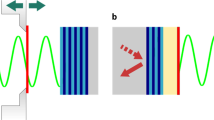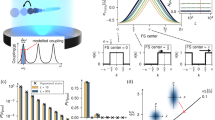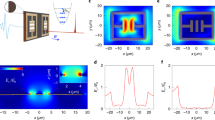Abstract
In spite of their different natures, light and matter can be unified under the strong-coupling regime, yielding superpositions of the two, referred to as dressed states or polaritons. After initially being demonstrated in bulk semiconductors1 and atomic systems2, strong-coupling phenomena have been recently realized in solid-state optical microcavities3. Strong coupling is an essential ingredient in the physics spanning from many-body quantum coherence phenomena, such as Bose–Einstein condensation4 and superfluidity5, to cavity quantum electrodynamics. Within cavity quantum electrodynamics, the Jaynes–Cummings model6,7,8 describes the interaction of a single fermionic two-level system with a single bosonic photon mode. For a photon number larger than one, known as quantum strong coupling, a significant anharmonicity is predicted for the ladder-like spectrum of dressed states. For optical transitions in semiconductor nanostructures, first signatures of the quantum strong coupling were recently reported9. Here we use advanced coherent nonlinear spectroscopy to explore a strongly coupled exciton–cavity system10,11. We measure and simulate its four-wave mixing response12,13, granting direct access to the coherent dynamics of the first and second rungs of the Jaynes–Cummings ladder. The agreement of the rich experimental evidence with the predictions of the Jaynes–Cummings model is proof of the quantum strong-coupling regime in the investigated solid-state system.
This is a preview of subscription content, access via your institution
Access options
Subscribe to this journal
Receive 12 print issues and online access
$259.00 per year
only $21.58 per issue
Buy this article
- Purchase on Springer Link
- Instant access to full article PDF
Prices may be subject to local taxes which are calculated during checkout




Similar content being viewed by others
References
Hopfield, J. J. & Thomas, D. G. Polariton absorption lines. Phys. Rev. Lett. 15, 22–25 (1965).
Kaluzny, Y., Goy, P., Gross, M., Raimond, J. M. & Haroche, S. Observation of self-induced Rabi oscillations in two-level atoms excited inside a resonant cavity: The ringing regime of superradiance. Phys. Rev. Lett. 51, 1175–1178 (1983).
Weisbuch, C., Nishioka, M., Ishikawa, A. & Arakawa, Y. Observation of the coupled exciton–photon mode splitting in a semiconductor quantum microcavity. Phys. Rev. Lett. 69, 3314–3317 (1992).
Kasprzak, J. et al. Bose–Einstein condensation of exciton polaritons. Nature 443, 409–414 (2006).
Amo, A. et al. Superfluidity of polaritons in semiconductor microcavities. Nature Phys. 5, 805–810 (2009).
Jaynes, E. & Cummings, F. Comparison of quantum and semiclassical radiation theory with application to the beam maser. Proc. IEEE 51, 89–109 (1963).
Laussy, F. P., Glazov, M. M., Kavokin, A. V., Whittaker, D. M. & Malpuech, G. Statistics of excitons in quantum dots and their effect on the optical emission spectra of microcavities. Phys. Rev. B 73, 115343 (2006).
del Valle, E., Laussy, F. P. & Tejedor, C. Luminescence spectra of quantum dots in microcavities. II. Fermions. Phys. Rev. B 79, 235326 (2009).
Faraon, A. et al. Coherent generation of non-classical light on a chip via photon-induced tunnelling and blockade. Nature Phys. 4, 859–863 (2008).
Reithmaier, J. P. et al. Strong coupling in a single quantum dot-semiconductor microcavity system. Nature 432, 197–200 (2004).
Yoshie, T. et al. Rabi splitting with a single quantum dot in a photonic crystal nanocavity. Nature 432, 200–203 (2004).
Langbein, W. & Patton, B. Heterodyne spectral interferometry for multidimensional nonlinear spectroscopy of individual quantum systems. Opt. Lett. 31, 1151–1153 (2006).
Borri, P. & Langbein, W. in Semiconductor Quantum Bits (eds Henneberger, F. & Benson, O.) Ch. 12 (Pan Stanford Publishing, 2009).
Brune, M. et al. Quantum Rabi oscillation: A direct test of field quantization in a cavity. Phys. Rev. Lett. 76, 1800–1803 (1996).
Göppl, M. et al. Climbing the Jaynes–Cummings ladder and observing its nonlinearity in a cavity QED system. Nature 454, 315–318 (2008).
Khitrova, G., Gibbs, H. M., Kira, M., Koch, S. W. & Scherer, A. Vacuum Rabi splitting in semiconductors. Nature Phys. 2, 81–90 (2006).
Löffler, A. et al. Semiconductor quantum dot microcavity pillars with high-quality factors and enlarged dot dimensions. Appl. Phys. Lett. 86, 111105 (2005).
Reitzenstein, S. et al. AlAs/GaAs micropillar cavities with quality factors exceeding 150.000. Appl. Phys. Lett. 90, 251109 (2007).
Münch, S. et al. The role of optical excitation power on the emission spectra of a strongly coupled quantum dot–micropillar system. Opt. Express 17, 12821–12828 (2009).
Acknowledgements
J.K. and W.L. acknowledge support by the European Commission under the FP7-PEOPLE-2007-2-1-IEF ‘CUSMEQ’ contract No 219762. E.A.M. acknowledges support of WIMCS and RFBR. S.R., C.K., C.S., M.S., S.H. and A.F. acknowledge support by the Deutsche Forschungsgemeinschaft through the research group ‘Quantum Optics in Semiconductor Nanostructures’ and the State of Bavaria.
Author information
Authors and Affiliations
Contributions
Experiments were designed by W.L. and carried out by J.K., W.L. and S.R. Data were analysed and interpreted by J.K., W.L. and E.A.M. The theory was developed by E.A.M. and W.L. The manuscript was written by J.K., W.L., E.A.M., S.R. and S.H. The sample was grown and processed by S.R., C.K., C.S., M.S., S.H. and A.F.
Corresponding authors
Ethics declarations
Competing interests
The authors declare no competing financial interests.
Supplementary information
Supplementary Information
Supplementary Information (PDF 1183 kb)
Rights and permissions
About this article
Cite this article
Kasprzak, J., Reitzenstein, S., Muljarov, E. et al. Up on the Jaynes–Cummings ladder of a quantum-dot/microcavity system. Nature Mater 9, 304–308 (2010). https://doi.org/10.1038/nmat2717
Received:
Accepted:
Published:
Issue Date:
DOI: https://doi.org/10.1038/nmat2717
This article is cited by
-
Accessing the degree of Majorana nonlocality in a quantum dot-optical microcavity system
Scientific Reports (2022)
-
A gated quantum dot strongly coupled to an optical microcavity
Nature (2019)
-
Multi-wave coherent control of a solid-state single emitter
Nature Photonics (2016)
-
Purification of a single-photon nonlinearity
Nature Communications (2016)
-
Emitters of N-photon bundles
Nature Photonics (2014)



